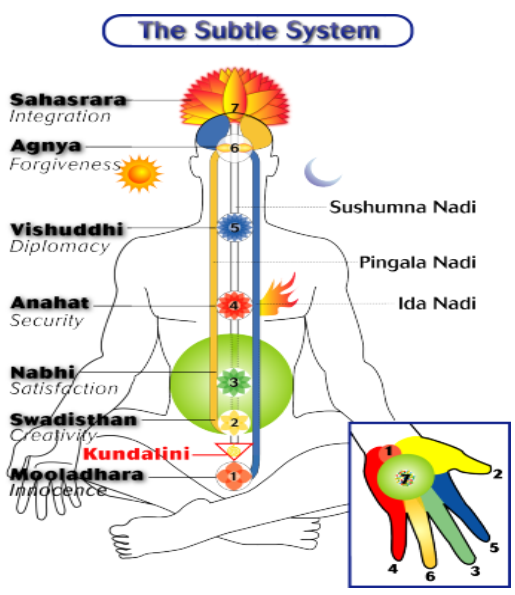Music Therapy with Indian Classical Music - An Introduction

Indian Classical Music (ICM) is an ancient musical tradition that has been in existence since millennia. It is a tradition based on spirituality.
Vedic chants (chants based on the 4 vedas or spiritual texts) have been sung in the tradition of ICM since ancient times.
It is believed that ICM originated with the first sound — AUM - that filled the Universe at its beginning.
AUM is the sound of auspiciousness. Auspiciousness that surrounded the “birth” of the Cosmos, of new beginnings.
AUM is also the combination of 3 powers i.e. the power of Creation, the power of Destruction and the power of Sustenance and Evolution.
From that first sound, music began to fill the universe.
Aeons passed.
In deep meditation, sages discovered that there were natural sounds that matched the frequencies of the human body and our inner subtle system.
It was discovered that there are 7 main chakras (or energy centers) and 3 nadis (or energy channels) within each of us. This makes up the subtle system in human beings and provides the energy for all physical activities and functions of the body, mind and soul.
Thus, the idea of the 7 notes was born. This idea is similar to Western Classical Music (WCM).
The difference in ICM is that each note is thought to correspond to a particular chakra with a musical frequency that matches that chakra. The names of the 7 notes were given in honour of animals that were said to make sounds in that note.
The music note names, animals, matching chakra (refer to the chart in this post) and organs of the body are :-
Shadja (Sa) : Peacock : Mooladhara chakra : Genitals, rectum
Rishabh (Re) : Bull : Swadhistan chakra : Rest of the reproductive system, Lower part of the stomach, pancreas, kidneys, liver, alimentary canal
Gandhar (Ga) : Sheep : Nabhi chakra : Upper part of the stomach, pancreas, kidneys, liver
Madhyam (Ma) : Crane : Anahat chakra : Heart, lungs
Pancham (Pa) : Cuckoo : Vishudhi chakra : throat, shoulders, skin, face, nose, ears, eyes, 5 senses
Dhaivat (Dha) : Horse : Agnya chakra : all parts of the head/brain except limbic area
Nishad (Ni) : Elephant : Sahasrara chakra : Limbic area
Aside from these 7 main notes, there are 4 flat notes (Re, Ga, Dha, Ni) and 1 sharp note (Ma) that made up the 12 basic notes of ICM.
In a way, this is a simplification. In ICM, it is considered that human beings are capable of differentiating between 22 notes that we hear. This means that each of these 12 basic notes are made up of between 1–2 shrutis (slight variations in frequency) of the basic notes.
The difference between ICM and WCM is also obvious when it comes to the position of the foundation note or Sa.
In WCM, all notes are fixed to a particular frequency. I.e. middle C always has the same frequency i.e. 261.6 Hz. In ICM, the base note Sa can be any frequency which is comfortable and natural for the singer/instrumentalist.
What this means is that Sa in ICM can fall on Bflat, C, D# or any other note that fits the pitch of the singer or musician.
But once Sa has been selected, all other notes will be fixed based on their relationship to Sa.
Another difference between ICM and WCM is that ICM emphasizes melody and rhythm while WCM emphasizes melody, rhythm and harmony.
The concept of harmony is not directly used in ICM. It is subtly hinted at in the secondary tones and notes while playing instruments or in the use of the tanpura or drone instruments.

My introduction to the very deep subject of Music Therapy through ICM started with the teachings of HH Shri Mataji Nirmala Devi, the founder of Sahaja Yoga (photo shown above)
I went on the develop it through my time with my teacher, the Late Pt Arun Apte. And till today, each day brings new discoveries from these experiences and the deep experience I have had guiding my students over more than 10 years.
Music is a universal language.
Music in heard and ultimately experience within. Also, our human system is the ultimate instrument that produces the end result — our voices.
Music Therapy with ICM uses the basic knowledge that I introduced above (and other deeper knowledge) to help balance and cleanse our subtle system.
Using the 7 notes for 7 chakras, we can correct the frequencies of the chakras. This balance restores and manifests the natural qualities of the chakras.
Music Therapy can also be used to balance the energies of the 3 channels — the left channel which deals with our emotions, the right channel which deals with our mental and physical activities and the center channel that deals with our evolution.
The natural qualities of the chakras that get expressed through Music Therapy with ICM are :-
Mooladhara : Innocence, Wisdom
Swadhistan : Creativity, Pure knowledge, Pure attention
Nabhi : Contentment
Anahat : Security, Confidence, Courage
Vishudhi : Communication, Clarity of the Senses
Agnya : Forgiveness, Balancing Ego and Conditionings
Sahasrara : Integration
I love this subject and the discoveries I have made in these connections both in myself and in the experiences of others...what an adventure within!
Upvoted you